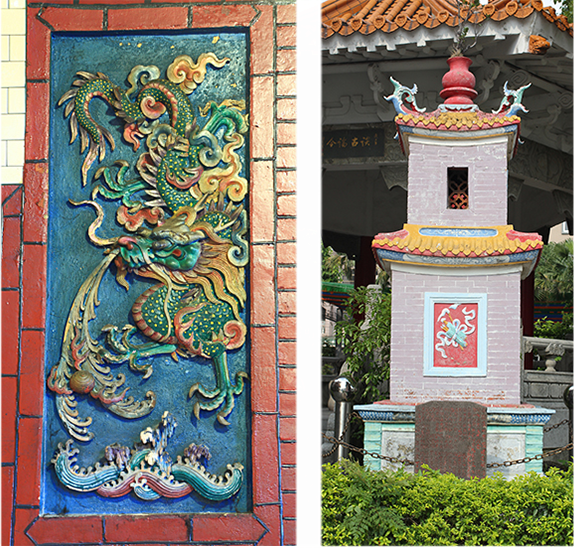Taoyuan has abundant variations of religious resource and multiple options for religious belief, including six of which that are listed in the “100 Religious Attractions in Taiwan” by Ministry of the Interior:
The texts and figures are extracted from the Taiwanese Religious Map- 100 Religious Attractions in Taiwan: https://www.taiwangods.com/html/landscape/1_001.aspx
5.The Oldest Temple of God of Wealth in Taiwan
Landscape Feature:
History:
Nankan Wufu Temple majorly worships Xuan Tan Marshal God of Wealth, Tzao, Kung-ming, and is one of the religious beliefs centers of Lu-zhu, Gue-shan and Da-yuan Districts. Legend has it that in the 13th year of Yongli of Ming Dynasty (1661), General Koxinga came shore to Taiwan and prayed for the protection of Xuan Tan Marshal, he then attacked Fort Provintia in Tainan in December, 1661, came ashore to Nankan Port in Spring, 1662 and stationed the troops at the mountainside of Mount Hutou (the current location of Wufu Temple). Tables and relics were placed under the camphor trees and worshiped the kinship of Xuan Tan Marshal, which later became the origins of the establishment of Wufu Temple in the 36th year of Yongli of Ming Dynasty (1682). Wufu Temple became religious sphere of the major five villages (Ding-chuang, Xia-chuang, Miao-ko, Luzhu-tsuo and Kan-zhi) of Nankan, in the major refurnish in the 15th year of Taisho era of Japanese colonization period (1924), the renowned carpenter master Chen, Yin-bing (1864-1944) and his excellent apprentice Liao, Shih-chen (1899-1985) and Master Tsai, Wan-ching’s student, Shui, Chin (dates of birth and death unknown) managed to refurnish the Temple separately, which completed one of the most famous religious architecture works with different designs in Taiwan. The stone statues, paintings, ceramics cutting and pasting and koji pottery are also made by artistic masters, and currently, the Temple is the the Taoyuan City Government designated historical spot.
Feature Guidance:
C.Koji Pottery by Su, Yang-sui:
Besides the wooden sculptures by Liao, Shih-chen, Shui, Chin and Huang, Gue-li (1903-1995), for the traditional decorations in the traditional architecture of Nankan Wufu Temple, the koji pottery works in the Temple can also attract the eyes of the professionals. The Dragon and Tiger Walls on the right and left sides of the Mina Hall were made by the koji pottery master Su, Yang-sui from Quanzhou in the 14th year of Taisho era of Japanese colonization period (1925). They are not only one of the rare works by Su, Yang-sui preserved in Taiwan, but also one of the invaluable precious of Wufu Temple as well as the artistic treasure of Taiwan.
D.Sacred Sign Pavilion:
The Sacred Sign Pavilion of Nankan Wufu Temple was constructed in the 5th year of Tongzhi Emperor of Qing Dynasty (1866) for the use of written words, funeral oration and ritual vessels incineration. It was first established near the archway, then moved to the park near the furnace on the left of the Temple in 2005 in order to avoid car crash. The two layers of the Pavilion are built with red bricks and the edges of each layer are decorated with figures of sacred beasts as dragons and phoenix, on the top the two words “Sacred Sign” are carved, and on the side of the Pavilion a stone tablet is placed to record the history and the donations from the society.

Useful Tips:
The biggest ceremony of Nankan Wufu Temple is the “Cultural Festival of Military God of Wealth” on March 15 and 16 of the Lunar Calendar that celebrates the birth of Xuan Tan Marshal. Folk temple activities from every part in Taiwan such as parade, family plays, Bei-guan music and Ba-jia-jiang plays all get together to join such lively religious ritual.
Information:
Address: No.1, Wufu Rd., Luzhu Dist., Taoyuan City
Geographic Coordination: 121.29517,25.05373
Fee: Free of charge
Open Dates:
24/7 for the whole year for the guidance
Open Hours: 6:00 A.M. ~ 9:00 P.M.
Tel: (03)322-7521
“Cultural Festival of Military God of Wealth” on March 15 and 16 of the Lunar Calendar